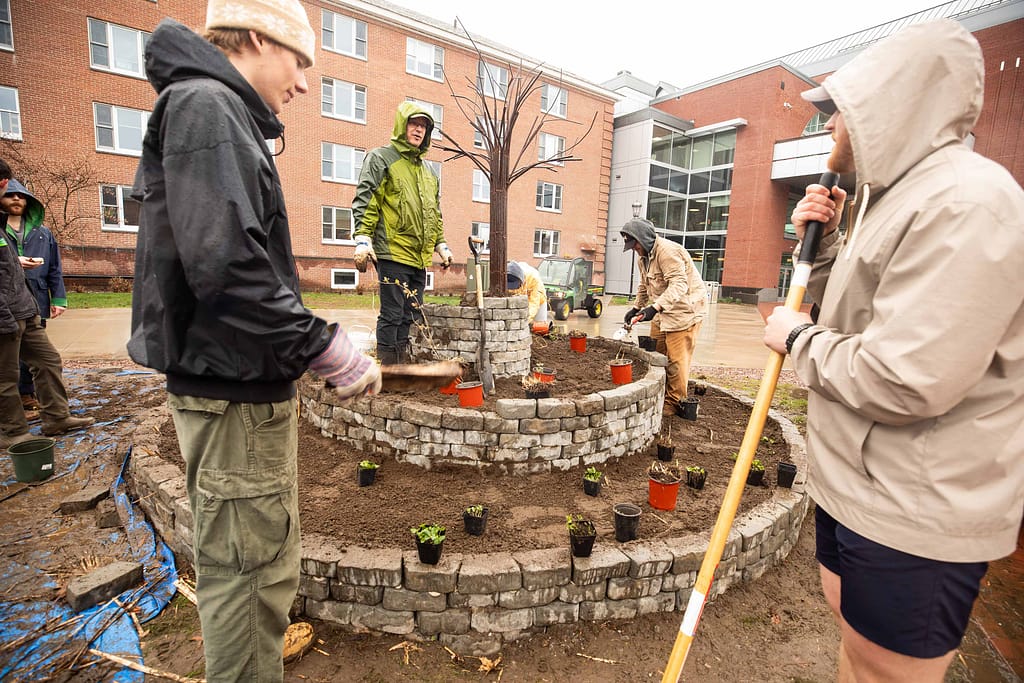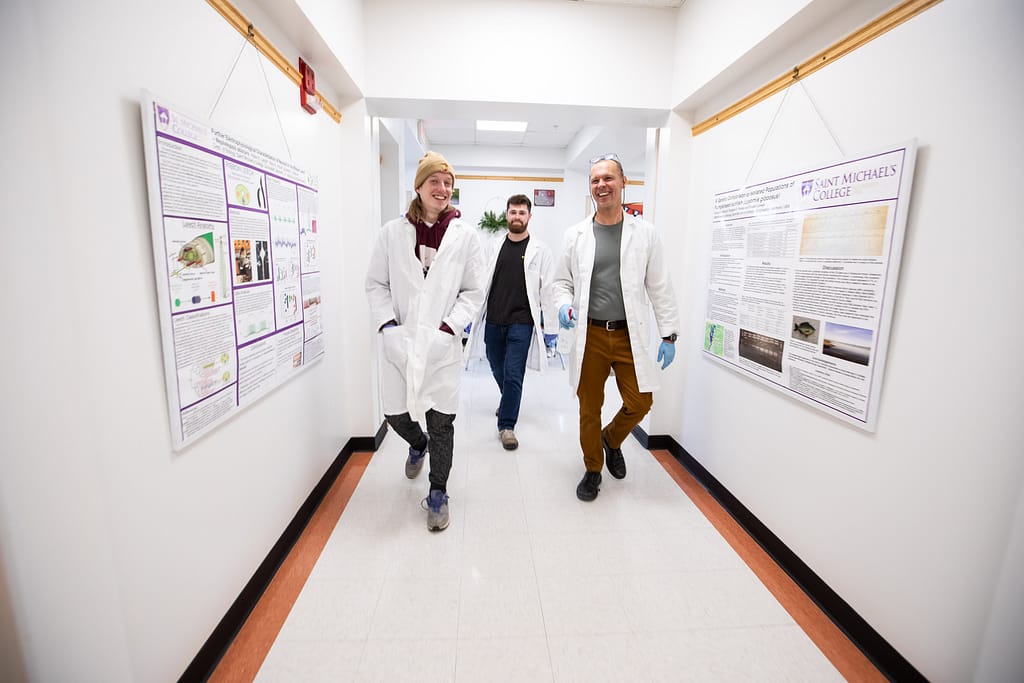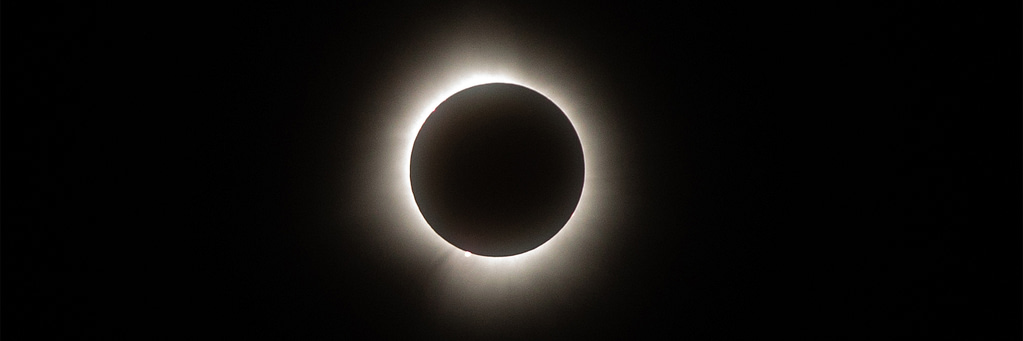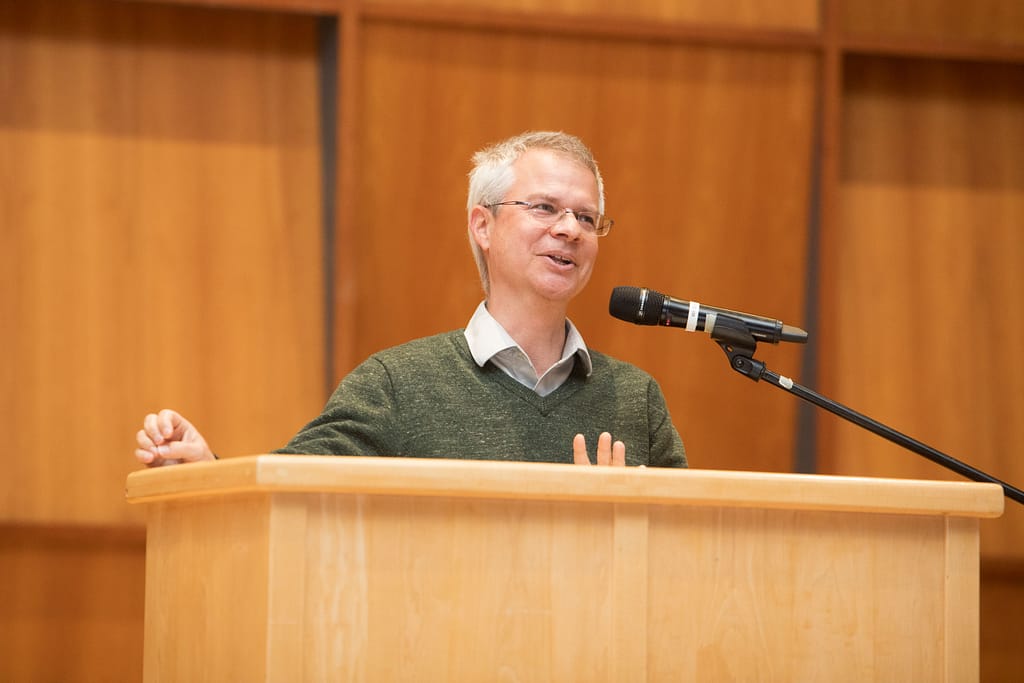Tree-giveaway surplus leads to windfall for Saint Michael’s
Students plant donations from Arbor Day Foundation in Natural Area on a sunny Thursday afternoon under supervision of Professors McCabe and Stanger; the timing is fortuitous with emerald ash borers threatening wooded areas across the region
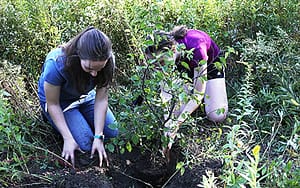
Two students plant a tree in the Natural Area during Thursday’s event. (photos by Lauren Read)
A surplus from an Arbor Day Foundation tree-giveaway program recently in Colchester and Winooski turned into a timely windfall for Saint Michael’s College at a time when the emerald ash borer poses imminent threat to so many ash trees on campus and in the College Natural Area, as well as throughout Vermont and the Northeast. It led to a well-attended tree-planting event for students Thursday sponsored by the campus environmental group Green Up on a near-perfect September afternoon.
Municipal and Foundation officials typically make a best rough estimation on trees to order each year through the program for any given town based on past years and possible current or expressed interest; when a shortage or surplus large or small inevitably emerges, the parties creatively improvise to best fill needs and use resources at hand.
This year’s surplus in Colchester and Winooski – a total of 65 trees without a forever home — led to a call from Foundation officials to St. Mike’s faculty biologist Declan McCabe. They knew McCabe from past collaborative work with him in the College’s Natural Area, where McCabe is a primary steward. That call and some checking around by the professor led to a fast green light for the College to take and plant the excess trees.
McCabe said the timing of the tree’s arrival is fortuitous, with emerald ash borers threatening so many ash trees on campus and around the state. The delivery included 12 river birch, 14 red oak, 3 red maple, 32 common hackberry and 4 serviceberry trees.
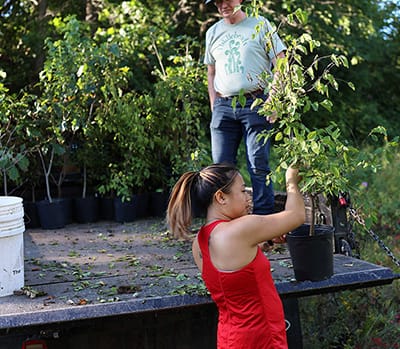
Sam Calloway ’22 of Green Up off-loads a tree for planting as Professor Declan McCabe stands on the truck bed to help.
Since McCabe needed some place to store and water them until he and the campus environmental group Green Up could arrange the planting day – Thursday, September 16 – he got permission from the Campus Ministry Director Fr. Brian Cummings, SSE ’86 to put them in the shade outside the chapel next to hose bibb, which was essential for watering.
“The Foundation folks were thrilled to have a taker who would plant them,” he said.
About the Arbor Day Foundation
Founded in 1972 — the centennial of the first Arbor Day observance — the Arbor Day Foundation, is (according to its mission statement), “the largest 501(c)3 nonprofit membership organization dedicated to planting trees. More than 1 million members, supporters, and partners have helped the Foundation plant more than 350 million trees in neighborhoods, communities, cities, and forests throughout the world to ensure a greener and healthier future for everyone.”
McCabe said both the type and size of the trees helps determine where they went or might go. “These are all smaller trees than we would typically plant on campus, but some may well be large enough to put in campus locations,” he said. “Tree species is also important: the red oaks for example are an upland tree and we will not put them in the conservation easement; instead they will go elsewhere in the Natural Area where their roots can be drier and they will be happier”
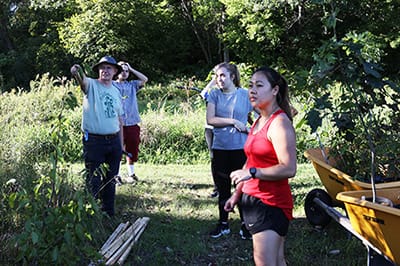
Declan McCabe, left, directs students to a site for tree-planting.
He said the hackberries, on the other hand, can handle being in damper areas, though not exactly wetland. “Approaching the other extreme, we have river birches that can stand more moisture and we will use them shade some new wetlands in the upper field. I intend to reserve a couple of them for an alumni planting on Saturday.” (Saint Michael’s is having its annual Alumni and Family Weekend September 17-19.)
Decisions about possible location of trees around campus will come from the Facilities team, including director Joel Ribout and staffers Russ Sabens and Ryan Longe.
A wide range of tree species can be found around the St. Mike’s campus, including many non-native trees planted over the years. “Campus trees need to be durable and thrive on minimal care in wind-exposed conditions, McCabe said. “There are some species that simply can’t handle that sort of habitat and may well be better suited to being in the woods. For the Natural Area, we try really hard to plant native species, and by that I mean species native to northern New England. “
Yet, since that was not always the campus policy, several non-natives got planted in the Natural Area in decades past. Norway spruce is a prime example, he said, explaining that several were planted for Earth Day a few decades back. “That’s not a decision we would make today,” McCabe said. “There was also a nursery run out of the Natural Area decades ago, and several of the nursery stock remain and are now full-grown canopy trees.”
McCabe said this is the first donation of trees to the College from the Arbor Day Foundation. “They became aware of our work on campus and in the Natural Area when some of their volunteers worked with us in their official capacities as arborists in helping us address the impending emerald ash borer crisis that will engulf campus in coming years,” he said.
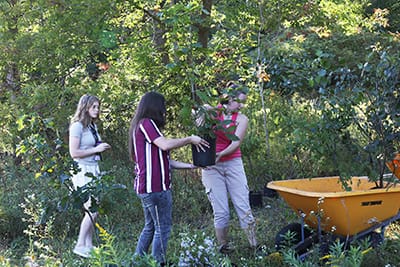
Students move trees to planting sites with a wheelbarrow.
“The donation came about because they ran a tree give away in two towns and not all trees were claimed, so we were invited to come last Saturday to take their excess trees. I showed up with a college truck anticipating 17 unclaimed trees from Colchester,” he said. “In the process, I learned that the Winooski team also had some unclaimed trees. In total the donation exceeded 60 trees, but the Natural Area is 365 acres so we can find a place for all of them.”
McCabe said it is “a virtual certainty that we will lose ash trees in the Natural Area and it will be important to have trees such as these to replace them. In addition we have more than 70 mature ash trees on campus and there is active discussion happening to plan on replacing those including three that were planted this spring and others coming in the fullness of time.”
Most of the donated trees range between three and five feet tall with a few of the river birches topping out at 10 feet, he said. “One could easily plant one of these in 15 minutes and with enough student help we anticipated planting 50-plus trees in 90 minutes on Thursday in the event hosted by Green Up, and that’s about how it worked out.” Facilities provided a truck for the planting event “and we borrowed all the shovels we could carry and set to work. We are utilizing compost from the college compost facility and wood chips that resulted from trees that were removed from campus over summer for various reasons,” he said. “Closing the circle I suppose.”
Samantha “Sam” Callaway ’22 and Tim Strzepa ’22 are the Green Up students responsible for hosting the group’s events and the tree-planting is the first formal event of the new semester. Trevien Stanger of the Environmental Studies and Science faculty is sponsor and adviser to the group, though McCabe said. “I’m always an interested supporter of Green Up.”
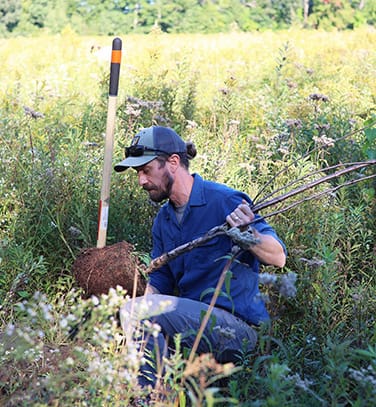
Trevian Stanger plants a tree Thursday.
“I often think of Trevien Stanger as our Lorax,” said McCabe. “He speaks for the trees. I rarely consider planting a tree without a conversation with Trevien. His depth of tree knowledge leaves this insect ecologist in the dust. He reminded me to find more shaded locations for our serviceberry trees just this morning.” The two have discussed some plantings for November when dormant bare-root trees can easily be transplanted, “and also a time when students will welcome an opportunity to get out of the classroom before the snow flies.”
He said the other activity he and Stanger are planning for the later fall will be “tree tubing” – “we need to wrap each planted tree’s trunk with a plastic tube to save them from the voles,” he explained. “Otherwise, when the snow gets up around the trunks, the voles travel under the snow where they are safer from owls, and eat off the bark thus killing the trees. So Trevien is number one tree planter and I’m a willing assistant. He has an additional planting planned for early October.”
Ultimately, he said, “we need to plant early and often both on campus and in the Natural Area. We are losing mature trees on campus for a variety of reasons and are about to be hit really hard when the ash start falling. If we are not continually planting, the place will start to look sparse and unwelcoming in a matter of years.”
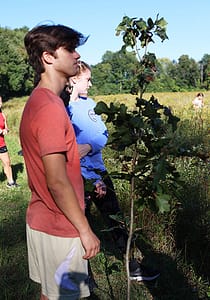
A man and his tree.
Toward that end, the College’s federal partners in the Natural Resources Conservation Service (NRCS) are planning a large spring planting. With larger budgets than we have, they will hire contractors to start filling the gaps where tree natural regeneration is not happening in the easement.
Part of the calculus in a project like this, he said, is that “when you plant a tree on campus, you need to keep it watered until it becomes established so it is a responsibility and another task for an already very busy crew,” so Facilities will be involved in most decisions.
The College has a tree nursery right in the middle of campus by the student centers, which bill provide staging area for mulch for students to spread. All the donated trees “are large enough and healthy enough to hold their own in the regenerating woods and so they will go straight into the ground without any time in the nursery,” he said.
As to long-term benefits from the plantings, McCabe said, “We as a college have taken on the responsibility of transitioning former cornfields to forest. The benefits include immediate learning experiences for students outside of traditional classrooms. There are slightly longer-term benefits to local wildlife in terms of acorns and hackberries produced, native insects nourished, and in turn birds fed.”
“In the long term, with life spans measured in hundreds of years, these trees will continue to capture and sequester carbon long after every current member of the campus community has shuffled off their mortal coil,” he said.
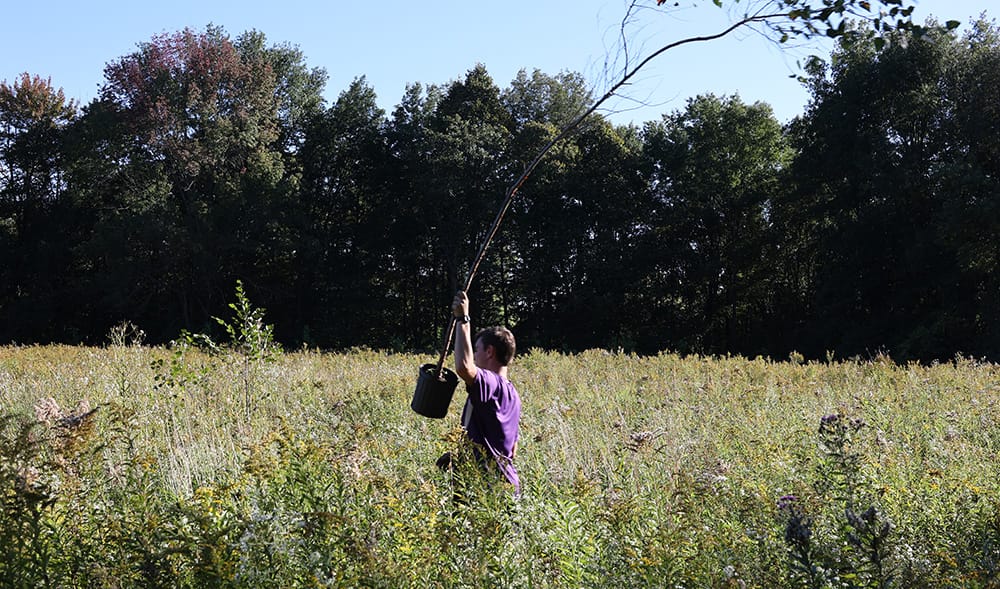
A tree-planting student carries his tree through the Natural Area meadow.

